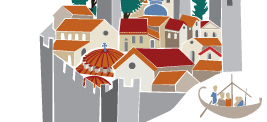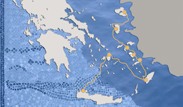Constantinople - Crete: “Nicephorus Phocas”
Exploration of the Byzantine
world could
not but include
the broad and
culturally rich
area
of
the Aegean
archipelago. Although the islands
did not play
a leading
role in the political,
religious and artistic
developments
of the Byzantine Empire,
they
did follow contemporary
trends
and serve as the theatre for many important
events. Byzantine monuments
preserved on the islands plainly and
eloquently depict
all those elements
which changed, influenced and
defined
history and culture
down the centuries;
attacks,
invasions
and violent
physical phenomena
can be traced
through the
ruined villages
and
crumbling
monuments. To this day, by examining the large
monastery
complexes, the extensive
and
prosperous
settlements
and the
many churches we can determine the periods of
boom
and
prosperity
experienced by
the
islands
and the entire
empire
at particular times.
The Constantinople -
Crete route was
named after
the Byzantine
emperor
Nicephorus
II
Phocas, for he was the one who
first traced it in history,
in
960. It was then that he set out from the
capital of the Byzantine Empire
for Crete,
which
he retook from the Arabs in 961, following several months of
operations. Using the imaginary line that links Constantinople to Crete
as our guide, the Nicephorus Phocas route presents selected
sites and
monuments
of the Aegean. The concept
behind this choice lay in a desire to
throw
light on
the Byzantine
and
post-Byzantine chapters of history
at particular places in the
Aegean
region, guiding
the reader
to places
and
monuments
of
great import,
as well as to
those
usually confined to the margins of
interest.
Readers
choosing
the Nicephorus Phocas route will
visit castles, monasteries, churches and
present-day
museums. The
virtual castle trail starts at
the
fortress
of Mytilene, heading via the castles
of Chios,
Leros, Kos, Rhodes
and Naxos to end at that
of Chania.
Nea
Moni
on Chios and
the Monastery of St.
John the
Theologian on
Patmos,
together
with
the early Christian
basilicas of
Kos and
the Episkopi at Kissamos,
mark out the trail of religious
monuments.
The interactive
tour
is complemented by
a modern-day
glance back
into the past
via museums on Chios, at
the Nicolaides Mansion
on Patmos
and on Leros.
The unique, interesting
knowledge acquired by visitors choosing to travel the Nicephorus Phocas
route
lies in
discovering the
patchwork of cultures and hues in the Aegean of Byzantine times. As a living space laid claim to by many
different peoples, the Byzantine Aegean boasts
the brilliant
colors
of the mosaics at Nea Moni,
the complex design
of the castle
at Naxos,
the robustness
of the Knights’ Castle,
and
the energy of all
the people
(Greeks, Venetians, Ottomans) that navigated and
inhabited it
down the
centuries, with all their various languages, religions, experiences, backgrounds and
purposes.
at Nea Moni,
the complex design
of the castle
at Naxos,
the robustness
of the Knights’ Castle,
and
the energy of all
the people
(Greeks, Venetians, Ottomans) that navigated and
inhabited it
down the
centuries, with all their various languages, religions, experiences, backgrounds and
purposes.
Trail stops catalog
Bibliography (0)▼
Comments (0)▼
New Comment▼






